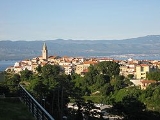
Vrbnik
Encyclopedia
Vrbnik is a Croatia
n village perched on a rocky outcrop by the Adriatic Sea
on the east coast of the island of Krk
. Originally a walled village, Vrbnik was established in medieval times. It is known for its local wine called Zlahtina. It has a population of 944 (2001); there are a total of 1,245 people in the municipality of Vrbnik, which includes three other nearby villages (Garica with 149 inhabitants (2001), Kampelje with 6 inhabitants (2001), and Risika with 146 inhabitants (2001).
Places of cultural significance include the Vitezić library, the Gothic Chapel of the Rosary and the Chapel of St. John in the Parish Church of the Assumption, and a collection of ancient manuscripts and Glagolitic documents housed at the parish church.
Croatia
Croatia , officially the Republic of Croatia , is a unitary democratic parliamentary republic in Europe at the crossroads of the Mitteleuropa, the Balkans, and the Mediterranean. Its capital and largest city is Zagreb. The country is divided into 20 counties and the city of Zagreb. Croatia covers ...
n village perched on a rocky outcrop by the Adriatic Sea
Adriatic Sea
The Adriatic Sea is a body of water separating the Italian Peninsula from the Balkan peninsula, and the system of the Apennine Mountains from that of the Dinaric Alps and adjacent ranges...
on the east coast of the island of Krk
Krk
Krk is a Croatian island in the northern Adriatic Sea, located near Rijeka in the Bay of Kvarner and part of the Primorje-Gorski Kotar county....
. Originally a walled village, Vrbnik was established in medieval times. It is known for its local wine called Zlahtina. It has a population of 944 (2001); there are a total of 1,245 people in the municipality of Vrbnik, which includes three other nearby villages (Garica with 149 inhabitants (2001), Kampelje with 6 inhabitants (2001), and Risika with 146 inhabitants (2001).
Places of cultural significance include the Vitezić library, the Gothic Chapel of the Rosary and the Chapel of St. John in the Parish Church of the Assumption, and a collection of ancient manuscripts and Glagolitic documents housed at the parish church.

